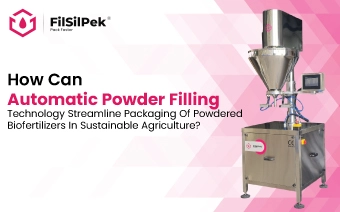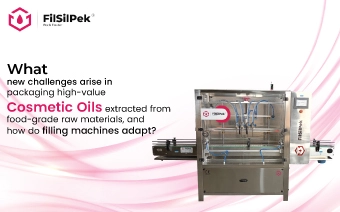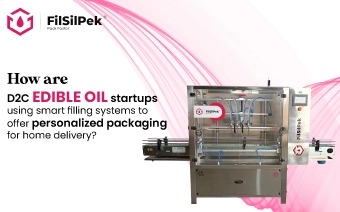How to Streamline Your Cosmetic Business with Cosmetic Filling Machines?
In the highly competitive cosmetic industry, where precision, speed, and product consistency are paramount, businesses need streamlined and efficient processes to stay ahead. Among the critical components that play a pivotal role in cosmetic production is the cosmetic filling line. These automated systems revolutionize the way cosmetics are filled into containers, offering numerous benefits to manufacturers and end consumers alike. From optimizing production workflows to ensuring accurate fill levels and maintaining product integrity, cosmetic filling lines have become an indispensable asset for cosmetic businesses.
In this blog post, we will explore the importance of cosmetic filling lines and how they enhance efficiency, productivity, and quality in the cosmetic industry. Join us as we delve into the world of cosmetic filling lines and uncover the key reasons why they are essential for the success of cosmetic businesses.
What are Cosmetic Filling Lines?
Cosmetic filling lines are advanced and automated systems designed to efficiently fill cosmetic products into various types of containers, such as bottles, jars, tubes, pumps, or sachets. These filling lines streamline the production process by automating the precise dispensing of cosmetic formulations into the containers, ensuring accurate fill levels, and maintaining product consistency and quality.
Cosmetic filling lines typically consist of multiple interconnected machines and components that work together seamlessly. The main components of a cosmetic filling line include:
- Container Feeding: This component handles the supply of empty containers to the filling line. It may involve mechanisms such as conveyor belts, rotary tables, or indexing systems to transport the containers to the filling station.
- Filling System: The filling system is the heart of the cosmetic filling line. It includes various filling mechanisms such as volumetric, piston, peristaltic, or gravity-based systems. These systems accurately dispense the desired quantity of cosmetic product into each container. The filling speed, accuracy, and precision are controlled and regulated by advanced sensors, meters, or weight-based systems.
- Capping and Sealing: Once the containers are filled, the capping and sealing components of the filling line securely close the containers to maintain product integrity. This may involve mechanisms like screw cappers, snap-on caps, induction sealers, or heat sealers, depending on the type of container and closure.
- Labeling and Coding: After the containers are filled and sealed, labeling and coding systems may be integrated into the filling line to apply labels, barcodes, batch numbers, or expiration dates to the containers. This ensures proper identification and traceability of the products.
- Inspection and Quality Control: Some cosmetic filling lines incorporate inspection systems to detect defects or improperly filled containers. Vision inspection systems, inline sensors, or automated rejection mechanisms can identify containers with incorrect fill levels, leaks, or other quality issues, ensuring that only high-quality products proceed through the line.
- Conveyor System: A conveyor system transports the containers through different stages of the filling line, including filling, capping, sealing, labeling, and inspection. It ensures a smooth and continuous flow of containers, optimizing the production process and reducing downtime.
- Control and Monitoring: Cosmetic filling lines are equipped with control panels or human-machine interfaces (HMIs) that allow operators to monitor and control the line’s operation. Parameters such as filling speed, fill levels, capping torque, and overall line performance can be adjusted and monitored to ensure optimal productivity and quality.
Cosmetic filling lines are designed to meet industry standards and regulations, incorporating features that promote hygiene, ease of cleaning, and maintenance. They are customizable to accommodate different container sizes, shapes, and closure types, providing flexibility for cosmetic manufacturers to meet diverse product packaging requirements.
Importance of Cosmetic Filling Lines in Cosmetic Business
Cosmetic filling lines play a crucial role in streamlining the cosmetic filling process by automating and optimizing various stages of the process. Here’s how cosmetic filling lines streamline the cosmetic filling process:
Automated Filling
Cosmetic filling lines automate the process of filling cosmetic products into containers. They use advanced technologies such as volumetric, piston, or peristaltic filling systems to precisely dispense the desired quantity of product into each container. This automation eliminates the need for manual filling, reducing labor-intensive tasks and minimizing the chances of errors or inconsistencies.
High-Speed Operation
Cosmetic filling lines are designed for high-speed operation, allowing for efficient and rapid filling of products. They can handle a large number of containers per minute, significantly increasing production throughput compared to manual filling methods. This speed enables cosmetic businesses to meet tight deadlines, fulfill large orders, and keep up with market demands effectively.
Accurate Fill Levels
Precise filling control is a crucial aspect of cosmetic production, ensuring consistent fill levels across all products. Cosmetic filling lines employ advanced sensors, meters, or weight-based systems to achieve accurate fill levels, minimizing the risk of overfilling or underfilling. This accuracy enhances product quality, eliminates wastage, and prevents customer dissatisfaction due to inconsistent product quantities.
Flexibility for Different Containers
Cosmetic filling lines offer flexibility to accommodate various types of containers, sizes, and shapes. They can handle bottles, jars, tubes, pumps, or other packaging formats commonly used in the cosmetics industry. This flexibility allows cosmetic businesses to produce a diverse range of products and cater to different customer preferences without the need for extensive reconfiguration or setup changes.
Integration with Capping and Sealing
In addition to filling, cosmetic filling lines often integrate capping and sealing mechanisms. These automated processes ensure proper closure of the containers, maintaining product integrity and preventing leaks or contamination. By combining filling, capping, and sealing operations in a single line, cosmetic businesses can achieve a seamless and efficient production flow.
Quality Control and Inspection
Cosmetic filling lines often incorporate quality control mechanisms, such as vision inspection systems or inline sensors, to detect and reject defective or improperly filled containers. This real-time quality control minimizes the risk of releasing faulty products into the market, upholds product consistency, and maintains brand reputation.
Hygiene and Cleanliness
Cosmetic filling lines prioritize hygiene and cleanliness to meet industry regulations and ensure product safety. They feature designs that facilitate easy cleaning, sterilization, and sanitization processes. Components like clean-in-place (CIP) systems, stainless steel construction, and quick-change parts enable efficient maintenance and minimize the risk of cross-contamination.
Workflow Integration and Monitoring
Modern cosmetic filling lines can be integrated into a larger production workflow, incorporating data exchange and monitoring capabilities. They can connect with manufacturing execution systems (MES) or enterprise resource planning (ERP) systems, enabling real-time monitoring of production metrics, inventory levels, and production scheduling. This integration optimizes overall production efficiency, enables data-driven decision-making, and streamlines the entire cosmetic manufacturing process.
By automating the filling process, ensuring accuracy, accommodating different containers, integrating with capping and sealing, implementing quality control, and emphasizing hygiene, cosmetic filling lines streamline the cosmetic filling process from start to finish. These advancements enhance production efficiency, reduce costs, improve product quality, and support cosmetic businesses in meeting market demands effectively.
Quick Tips to Follow While Adopting Cosmetic Filling Lines
When adopting cosmetic filling lines, it’s essential to follow certain tips to ensure a smooth transition and maximize the benefits of the technology. Here are some quick tips to keep in mind:
Assess Your Production Needs
Before investing in a cosmetic filling line, assess your production requirements, including expected volume, container types, and product formulations. This will help you choose a filling line that aligns with your specific needs and ensures optimal performance.
Conduct a Cost-Benefit Analysis
Evaluate the costs associated with acquiring and implementing a cosmetic filling line and compare them with the potential benefits. Consider factors such as increased production efficiency, reduced labor costs, improved product quality, and scalability. This analysis will help you make an informed decision regarding the investment.
Research Reliable Suppliers
Take the time to research and choose a reputable supplier or manufacturer for your cosmetic filling line. Look for experienced providers who offer reliable equipment, good customer support, and a track record of delivering quality solutions. Request references or visit other facilities using their equipment to assess its performance.
Consider Customization Options
Cosmetic filling lines should be customizable to accommodate different container sizes, shapes, and closure types. Ensure that the filling line can be tailored to meet your specific packaging requirements and product portfolio. This flexibility will allow you to adapt to changing market needs and expand your product offerings in the future.
Train Your Staff
Proper training is crucial for the successful implementation and operation of cosmetic filling lines. Ensure that your staff receives comprehensive training on using and maintaining the equipment. This will optimize productivity, reduce downtime, and minimize the risk of errors or accidents.
Implement Quality Control Measures
Integrate quality control mechanisms within the cosmetic filling line to detect and reject defective or improperly filled containers. Implement vision inspection systems, inline sensors, or other relevant technologies to ensure product integrity and meet quality standards.
Prioritize Maintenance and Upkeep
Regular maintenance is essential to keep the cosmetic filling line running smoothly and prevent breakdowns. Follow the manufacturer’s recommended maintenance schedule and ensure that spare parts are readily available. Implement preventive maintenance practices and address any issues promptly to minimize downtime and maximize the lifespan of the equipment.
Continuously Monitor and Optimize
Monitor the performance of your cosmetic filling line regularly. Track key metrics such as production throughput, fill accuracy, and reject rates. Analyze the data to identify areas for improvement and implement optimizations to enhance efficiency and productivity.
Conclusion
The cosmetic industry must embrace the adoption of automated cosmetic filling lines to stay competitive in today’s fast-paced market. The advantages of these advanced systems, such as increased production efficiency, precise filling control, flexibility for various container types, and enhanced product quality, are essential for meeting consumer demands and maintaining a strong brand reputation.
By investing in automated cosmetic filling lines, cosmetic businesses can optimize their production processes, reduce costs, and streamline operations, ultimately gaining a significant advantage over competitors.
Embracing automation in cosmetic filling is not just a trend but a necessary step for industry players to remain at the forefront of innovation and meet the ever-growing demands of consumers in the dynamic world of cosmetics.
How can automatic powder filling technology streamline packaging of powdered biofertilizers in sustainable agriculture?
The demand for biofertilizers has increased sharply as agriculture moves toward….
What new challenges arise in packaging high-value cosmetic oils extracted from food-grade raw materials, and how do filling machines adapt?
High-value cosmetic oils like argan, almond, jojoba, avocado….
How are D2C edible oil startups using smart filling systems to offer personalized packaging for home delivery?
Direct-to-consumer (D2C) edible oil brands are changing the way households buy and use cooking oils. By cutting….



